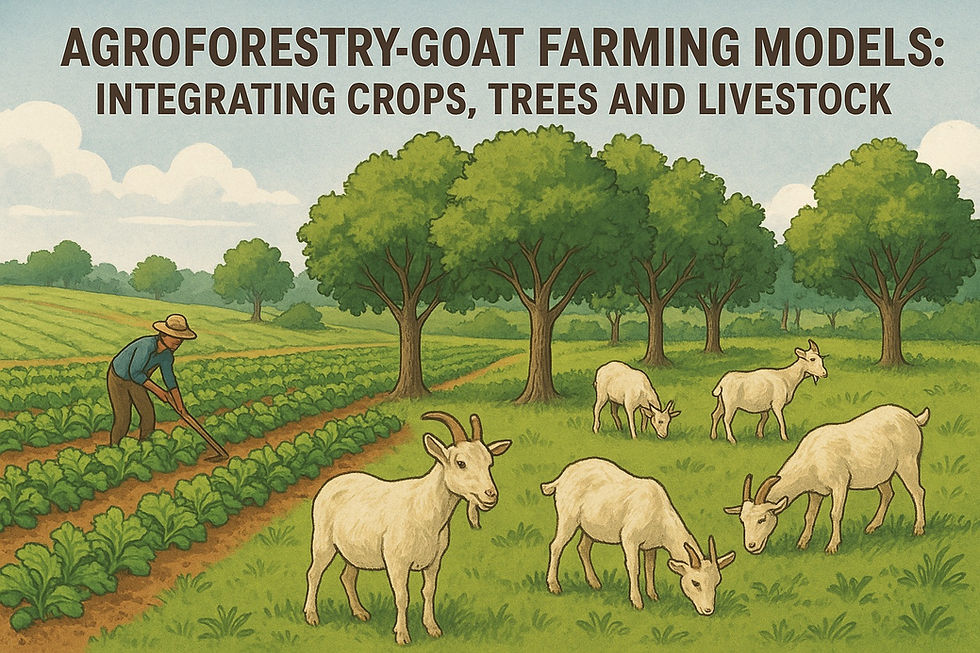Liquid Gold: The Critical Role of Water in Small Livestock Farming
- TGT GLOBAL Development services
- Oct 30
- 3 min read
In the vast and varied agro-climatic regions of India, small livestock—goats, sheep, backyard poultry and pigs—form the cornerstone of rural livelihoods, particularly for landless and marginal farmers. Yet, behind every thriving herd or flock lies an often overlooked but absolutely vital resource: water. In the world of small livestock farming, water is not just a natural resource—it's liquid gold, influencing productivity, animal health, income and long-term sustainability.
Why Water Matters in Small Livestock Systems: Though small livestock are more drought-tolerant than cattle or buffalo, their daily water needs are non-negotiable. Clean water is essential for:
Drinking and Thermoregulation: Animals need sufficient hydration, especially in hot climates, to maintain body temperature, digestion and metabolic function.
Feed Digestion: Water aids in digesting dry feed and concentrates. A lack of water can reduce feed intake and nutrient absorption.
Lactation and Growth: Lactating animals and growing kids require more water. Even minor dehydration can lead to drop in milk yield or weight gain.
Disease Prevention: Stagnant or contaminated water increases risks of diarrhoea, parasitic infections and zoonotic diseases like leptospirosis or cryptosporidiosis.
Hygiene and Housing: Cleaning pans as Water is essential, maintaining hygiene and controlling flies and pests.
Water Scarcity: A Hidden Threat to Livestock Livelihoods
In many dryland and tribal regions of India, water scarcity isn't just a human issue—it directly hampers the small livestock economy. Droughts force pastoralists to migrate or sell animals prematurely. Women and children walk miles to fetch water, leaving animals underfed or untreated. In peri-urban areas, increasing pollution and competition for water from industry and domestic uses adds another layer of risk.
Water scarcity in small livestock farming leads to:
Stress-induced abortions and poor fertility
Poor weight gain and reduced market value
High mortality among young animals
Increased disease incidence and treatment costs
Building Water Resilience in Livestock Systems: To safeguard small livestock livelihoods, water resilience must be embedded into every level of planning—from household farms to government policies. Key approaches include:
1. Decentralized Water Harvesting
Construction of farm ponds, percolation tanks and roof water harvesting systems ensures water availability at the doorstep.
Encouraging community-managed water assets for shared livestock use helps reduce individual burdens.
2. Water-Efficient Fodder Strategies
Promotion of hydroponic green fodder or azolla cultivation can reduce the overall water footprint of animal feed.
Agroforestry and silvopasture systems increase moisture retention and diversify fodder sources.
3. Clean Water Access and Infrastructure
Installing low-cost water filters and providing drinking troughs reduces contamination risks.
Training for women and Pashu Sakhis on water sanitation ensures safe water for livestock and humans alike.
4. Convergence with Government Schemes
Leveraging programs like MGNREGS, Jal Jeevan Mission and Watershed Development Projects can help build sustainable water structures specifically tailored for livestock needs.
Gender, Water and Livestock: A Triangular Responsibility
In rural India, women often shoulder the triple burden of collecting water for households, livestock care and fodder production. Water scarcity disproportionately affects their time, income and mobility. By prioritizing gender-sensitive water solutions—like installing water points near homes or involving women in water-user groups—programs can improve both livestock outcomes and women’s empowerment.
In the changing climate and growing pressures on rural livelihoods, water is more than a necessity—it is a strategic enabler of livestock-based economic resilience. Treating water as “liquid gold” in small livestock farming isn’t poetic exaggeration—it’s a reality that policy, practice and planning must embrace. By investing in sustainable water access and usage, India can unlock the full potential of its small livestock sector and ensure dignified livelihoods for millions of its rural poor with rejuvenating the pond culture and tanka traditions to ensure water for everyone.



Comments